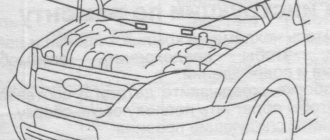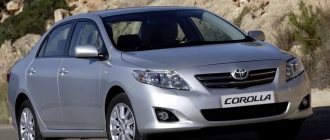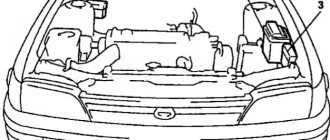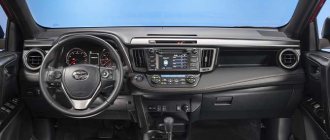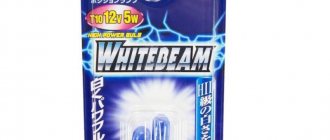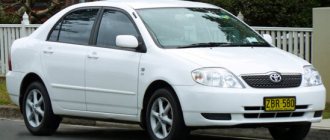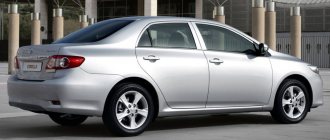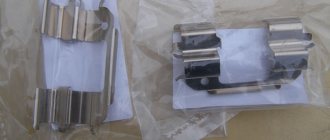What is a VIN code and what information does it contain?
The VIN code (short for Vehicle Identification Number) is a combination of 17 Arabic numbers and Latin letters.
Information is applied to body panels that cannot be removed without destroying the structure, or on special stickers or metal plates. The elements are installed with rivets (the fastening heads are compressed with a factory tool, which is difficult to counterfeit).
Each vehicle receives its own VIN, which is not repeated by any other vehicle manufacturer.
The VIN code for Toyota and any other car includes information about:
- manufacturer;
- modifications (in encoded form);
- model year;
- the factory that assembled the car;
- serial number.
Toyota RAV 4
The RAV 4 model has earned popularity due to its compactness, solid appearance and rich “filling”.
Production of the crossover began in 1994, and the car was initially aimed at young people. The number “4” in the name means the presence of permanent all-wheel drive.
Today this crossover is in considerable demand among car enthusiasts in the Russian Federation. Until recently, assembly was carried out only in Japan at two factories - Takaoka and Taharan. This was the case until August 22, 2021. It was on this day that the first car of the model rolled off the assembly line of the plant in St. Petersburg.
The cars are planned to be sold not only in Russia, but also in a number of other countries - Kazakhstan and Belarus.
Location of the car serial number
The location of the code on Toyota vehicles depends on the year of manufacture and the sales market. For example, the sticker on the Camry XV40 or Corolla E150 is located under the windshield on the driver’s side (accordingly, the installation location of the element differs for the right-hand and left-hand steering wheels).
On the Corolla E120 or Altezza (the model intended for the Japanese domestic market), the information is printed on metal labels mounted on rivets on the engine side of the engine shield.
On the dashboard
If the instrument panel is used to apply the code, then there is a recess on the plastic for installing a metal element or a sticker printed on special paper. When assembling the car, the main identifier is simultaneously cut on the body and additional labels are stuck on. The ferrite coating applied around the perimeter of the windshield has a rectangular cutout through which the vehicle's VIN code can be read.
Under the seat
The front seats of the car are attached to crossbars, which are parts of the load-bearing frame of the body floor. The ID details are cut by an engraving machine using original fonts. To read the code, you need to move the left seat back, and then fold back the valve provided in the carpet on the floor. On some cars (for example, Liteace or Hiace), the identification number is located on the floor panel in the driver's feet.
On the door frame
Labels are placed in the doorway on the driver's side indicating the vehicle's identification and additional parameters (for example, information about the weight of the vehicle and the ability to operate with a trailer, information about the color code of paint and interior, as well as certification for a number of markets). Special paper is used to print the ID. When peeled off, a layer of glue remains on the surface of the body, visible under the light of an ultraviolet lamp (the method is used by forensic scientists when conducting an examination of a car).
Service “Carmotospecs”
The Carmotospecs system continuously collects and stores millions of records of car sales, accidents, sales. You can easily track vehicle information.
If you are interested in decoding Toyota VIN, here are the instructions:
Step 1: Go to the “Carmotospecs” web page. Step 2: Enter the old vehicle's VIN into the "Enter VIN" text box. Step 3: Check the box to accept the terms. Check the box next to "You must check here to confirm your acceptance of the terms of use." And enter the verification code. Enter the verification code provided in the text box, then click "Search" to get a report on your vehicle.
Manual VIN decoding of Toyota European type
The car owner can decipher each character of the license plate using tables. It should be taken into account that the Toyota company changed the meaning of a number of characters in the encoding in 2002. Identifiers for machines supplied to Europe or North America also have a number of differences.
Regardless of the car’s release date, the identifier is usually divided into sections WMI (first 3 characters) and VDS (the next 6 characters) and an auxiliary field (8 characters).
Character table with meaning before 2002
The table shows the structure of the VIN identifier for Toyota products used before 2002.
| Character position in identifier | Decoding |
| From 1 to 3 | Designation of the vehicle manufacturer (WMI index, which included numbers and letters) |
| From 4 to 5 | Body type identification mark (both numbers and letters were used) |
| 6 | Engine code, which allows you to determine the generation of the power unit (letters were used for identification) |
| 7 | Model line of the car (indicated only by a letter of the Latin alphabet) |
| 8 and 9 | Model serial identifier designation |
| 10 | Reserve position (digit 0 was used) |
| From 11 to 17 | Machine serial number |
For example, the owner has a Toyota Carina with VIN number JT1LSTBK001234567, when decrypted you can get the following information:
- JT1 - a passenger car produced by the company for the European market;
- LS - a 5-door liftback body was used;
- T - a 2T or 3T generation engine is installed (they differ in displacement and fuel supply system, which are specified according to the documents for the vehicle);
- B - the car belongs to the Carina-Avensis model line;
- K0 - Carina E model (T190 generation);
- 0 — reserve position;
- 1234567 - serial number.
After 2002
Since 2002, the structure of the VIN code used by the Toyota concern has changed somewhat.
The data is shown in the table.
| Character position in identifier | Decoding |
| From 1 to 3 | WMI index, which allows you to clarify the world index of the car manufacturer |
| 4 | Type of body used and drive scheme (4x2 or 4x4) |
| 5 | Power unit identifier (Latin letter) |
| 6 | The serial number of the series (for example, the number 2 is used to designate the Land Cruiser Prado J120) |
| 7 | Features of the installed airbag system (allows you to determine the number and location of elements) |
| 8 | Model identifier (number or letter of the Latin alphabet) |
| 9 | Checksum sign |
| 10 | Model year identifier (information may be omitted, in this case the number 0 is entered) |
| 11 | Manufacturer (factories in Japan are reserved for numbers from 0 to 9; factories around the world are indicated by a letter) |
| From 12 to 17 | Machine serial number |
For example, the owner has a Corolla E120 car with the identifier SB1BZ28E53123456, the decoding of which allows one to obtain information that:
- SB1 - the car was produced by Toyota;
- B - the car is equipped with a 4-door sedan body and 1 axle drive;
- Z - under the hood there is a 16-valve 4-cylinder engine of the 1ZZ-FE or 3ZZ-FE series (differing in displacement);
- 2 - E120 series identifier;
- 8 — the cabin is equipped with front and side airbags;
- E - Auris or Corolla model (built on 1 platform, different bodies);
- 5 - determinant of the checksum, which is calculated using a special algorithm;
- 3 - the car belongs to the 2003 model year;
- 123456 - serial number.
When determining the model year, it should be taken into account that it uses numbers from 1 to 9 and Latin letters, making calculations from 1971. In 2001, a new cycle of using numbers and letters began (the last letter Y will be used in 2030).
For example, cars of the 2021 model year have the designation L in the identification number, and the letter M is reserved for 2021.
In which countries are Toyota cars produced, factories in Russia
The main country producing Toyota cars is Japan, but with the growing popularity of the concern's products, the need arose to cover current demand and open new factories.
So, step by step, Toyota production was established in many countries around the world - France, Great Britain, Indonesia and others. Russia was no exception, where the products of this brand are especially valued.
North American Market Breakdown
For vehicles sold in the US and Canadian markets, a modified coding is used to comply with local regulations. The initial version of identifiers for cars was introduced in 1981 and lasted until the end of 1995. Starting in 1996, changed markings began to be used (in a number of sources, the date of change in the structure of the number is erroneously assigned to 2002, by analogy with Europe).
Symbols before 2002
The structure of early type identification markings is shown in the table.
| Character position in identifier | Decoding |
| From 1 to 3 | WMI index to determine the world machine manufacturer index |
| 4 | Engine model identifier |
| 5 | Letter indicating model or platform |
| 6 | Model generation |
| 7 | A letter or number that allows you to clarify the model’s equipment |
| 8 | Body type coding |
| 9 | Check number |
| 10 | Model year |
| 11 | Vehicle assembly location |
| From 12 to 17 | Machine serial number |
For example, based on the code JT2FK14F8LN123456, you can get the following data:
- JT2 - the machine was assembled for the US and Canadian markets;
- F - 1MZ-FE engine used;
- K - the car is built on the Camry platform;
- 1 — the car belongs to the MR2/Camry or SXV10 generation (to be specified by date of assembly);
- 4 — standard equipment is used;
- F - a 4-door sedan body was used;
- 8 - determinant of the checksum, which is calculated using a special algorithm;
- L - 1990 model year;
- N - the car is assembled at the plant in Georgetown (Kentucky);
- 123456 — serial number of the copy.
Numbers after 2002
Since 1996, a number of changes have been introduced into the identifier structure, which are listed in the table.
| Character position in identifier | Decoding |
| From 1 to 3 | WMI Index |
| 4 | Body and drive type |
| 5 | Engine model |
| 6 | Series serial code number (the middle digit of the 3-digit identifier is used) |
| 7 | Description of the number of airbags |
| 8 | Model number |
| 9 | Check number |
| 10 | Model year |
| 11 | Assembly location |
| From 12 to 17 | Machine Serial ID |
For example, the VIN of the car JT2BF18K8X14F8LN123456 in decrypted form contains the information:
- JT2 - assembly for the USA or Canada;
- B — sedan body with 4 doors and 1 axle drive;
- F - 3.0-liter 1MZ-FE engine installed;
- 1 — model identifier;
- 8 — 4 airbags used;
- K - Camry model;
- 8 — checksum determinant;
- X - model corresponds to 1999;
- N - the car is assembled at the plant in Georgetown (Kentucky);
- 123456 - serial number.
Toyota Corolla
The Toyota Corolla model is considered one of the most popular in the Russian Federation. This is a compact vehicle, produced since 1966. Another 8 years later (in 1974) the car was included in the Guinness Book of Records - it became the best-selling car in the world.
In 2021, this model turned 50 years old, and during this period more than 40 million cars were sold.
Previously, the Corolla was assembled only in Japan, at the Takaoka plant. The situation changed in 2013, when the manufacturer introduced the 11th generation of the machine.
From now on, Corolla for Russia is being assembled in Turkey, in the city of Sakarya. Deliveries of automotive equipment are carried out through Novorossiysk.
Today, only “Turkish” Corolla cars are available to car enthusiasts in the Russian Federation, but real “Japanese” ones can also be found on the secondary market.
There is a lot of discussion about the build quality. According to reviews from car owners and specialists, it was almost not crushed.
The plant in Turkey has modern equipment installed, a staff of qualified employees has been recruited, and quality control is carried out by Toyota representatives themselves.
It is worth noting that previously, Corolla cars of the Japanese brand were already produced in Turkey (from 1994 to 2006). Cars were sold not only in the Russian Federation, but also in other countries.
Toyota FJ Cruiser
The FJ Cruiser from Toyota is a compact SUV made in an original retro style.
The concept was first presented in 2003, and production itself started two years later.
In the USA and Canada, the first sales started in 2007. Externally, the car resembles the FJ40 model, which was produced 50 years ago.
The car is produced only in Japan. However, in 2014, sales of this model in the United States were discontinued.
Over the past two years, cars have been available for purchase in the markets of Japan, China, Australia and a number of other countries. In 2021, the company announced its intention to discontinue production of the FJ Cruiser.
Toyota Hilux
The Toyota Hilux is a special medium-sized pickup truck that has been sold in Russia since 2010.
Thanks to the longitudinal arrangement of the engine, frame design, and all-wheel drive, the car has earned popularity all over the world. To date, eight generations of this car have been produced.
For the Russian Federation, Toyota Hilux is assembled in two countries - Thailand and South Africa. Generally speaking, assembly for other countries has also been established in Argentina and Indonesia.
Toyota Highlander
Another representative of the Japanese brand deserves special attention - Toyota Highlander. This vehicle belongs to the class of SUVs and is built on the basis of Toyota K.
The first performance took place in 2000. The main consumers are considered to be young people aged 20-30 years.
Initially, the model was intended for sales only in Japan. In terms of class, the Highlander is higher than the RAV 4, but inferior to the Prado.
The main consumers of this car are Americans, but there is also some demand in Russia.
The Russian Federation receives vehicles assembled in the USA (Indiana, Priston) and slightly adapted to local conditions.
Sienna minivans are also assembled here. The car is also produced in Japan, but these models are sent to EU countries.
Toyota Venza
The Toyota Venza belongs to the class of 5-seater crossovers. Initially, the car was produced for the USA, but since 2013 it was also presented on the Russian market.
Toyota Venza is positioned as a car for young families who travel a lot and love an active lifestyle. The first sales in the world started at the end of 2008.
The model is distinguished by its reliability, rich functionality and comfort. In 2012, shortly before the start of sales in Russia, a restyled version was presented.
Since 2015, the car has not been sold in the United States, and in 2021, sales ceased in the Russian market. Today, Toyota Venza can still be found in the markets of China and Canada.
Toyota Prius
The Toyota Prius is a mid-size “hybrid” from the Japanese brand that can run on gasoline and electricity. The battery has a large capacity, reaching 1.3-1.4 kWh.
The electric motor is capable of performing the functions of a generator and recharging the battery.
Car production is carried out exclusively in Japan, at the Tsutsumi plant. In 2015, a new generation of the car was presented, and already in February 2021, the first orders came from Russia.
Toyota Yaris
The Toyota Yaris model is a compact “Japanese”, made in a hatchback body. Production of the vehicle started in 1999.
The name Yaris was borrowed from the name of the ancient Greek goddess of joy and fun (original name - Charis).
The second name of the car is Vitz, but it only applies to cars produced for the Japanese market.
The car appeared in Europe and Japan in the same year - in 1999. In 2005, the 2nd generation car was introduced, and in 2006 sales started in Russia.
3rd generation cars were produced only in Japan, at the Yokohama plant, and were intended for the domestic market. Soon production started in France, from where the model goes to the EU and Russia.
Toyota Prado
The Toyota Land Cruiser Prado model is the pride of the Japanese concern. This SUV is rightfully considered one of the best representatives of the brand.
The advantages include an increased level of comfort, rich equipment, as well as a luxurious interior. The car is available in 3 and 5 door versions.
Starting from the second generation, production was carried out with an emphasis on the Toyota 4Runner platform, but already from the 3rd generation, production was established under the name Lexus GX.
Toyota Avensis
The next D-class representative from the Japanese brand is Toyota Avensis. The main competitors are Kia Optima, Volkswagen Passat, Opel Vectra and others.
On the European market, the car replaced the Toyota Karina E, and in 2007 the Avensis station wagon appeared, which replaced Kaldina.
Despite its Japanese origin, the car was never assembled on Japanese territory. And in general, Avensis is not intended for the Japanese market. The main consumers are the countries of Europe and Russia.
In the Russian Federation, cars manufactured in England are mainly sold at a plant in Derbyshire.
The first cars rolled off the assembly line in 2008, and a year later their number exceeded 115 thousand. There are no complaints about the quality - everything is done with English precision and scrupulousness.
